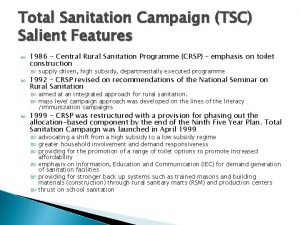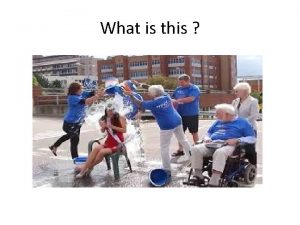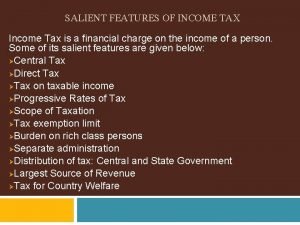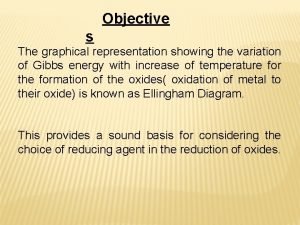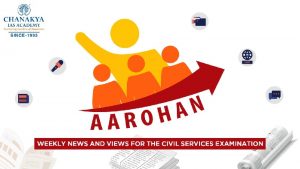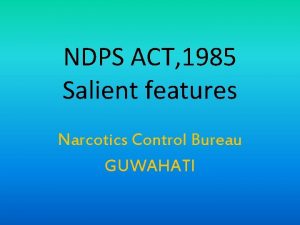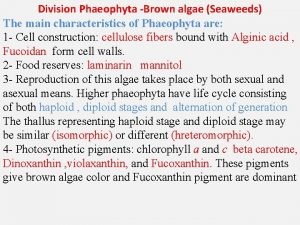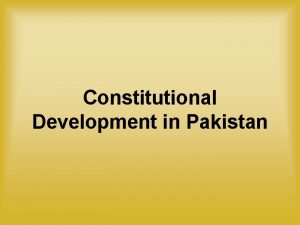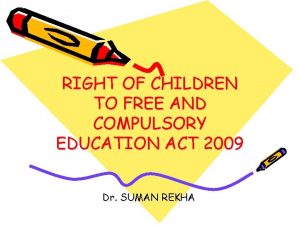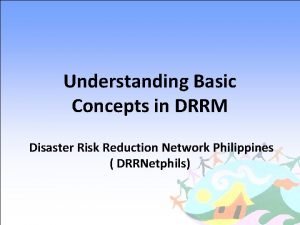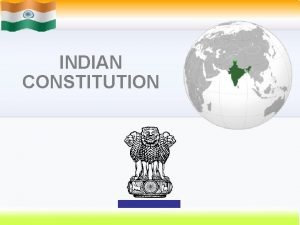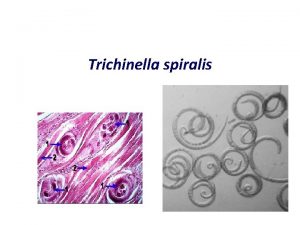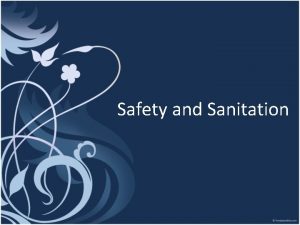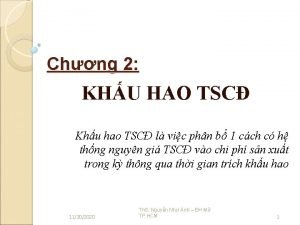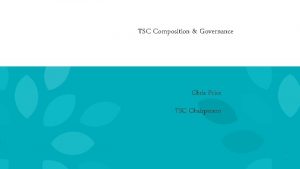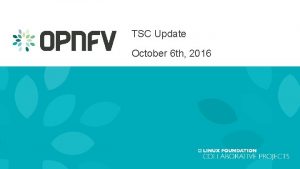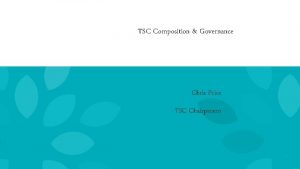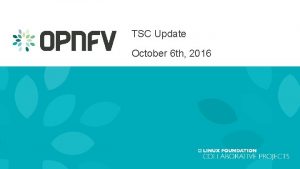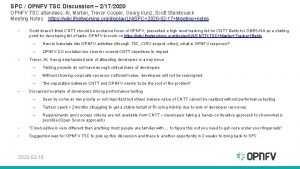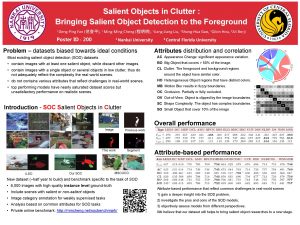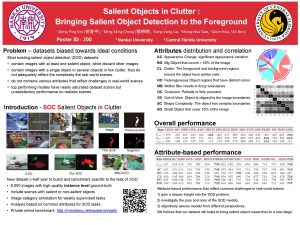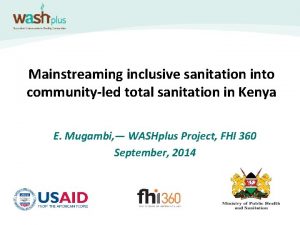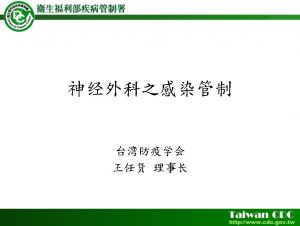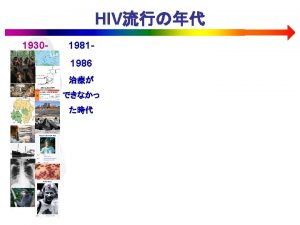Total Sanitation Campaign TSC Salient Features 1986 Central



















- Slides: 19

Total Sanitation Campaign (TSC) Salient Features 1986 - Central Rural Sanitation Programme (CRSP) – emphasis on toilet construction supply driven, high subsidy, departmentally executed programme 1992 – CRSP revised on recommendations of the National Seminar on Rural Sanitation aimed at an integrated approach for rural sanitation. mass level campaign approach was developed on the lines of the literacy /immunization campaigns 1999 - CRSP was restructured with a provision for phasing out the allocation-based component by the end of the Ninth Five Year Plan. Total Sanitation Campaign was launched in April 1999 advocating a shift from a high subsidy to a low subsidy regime greater household involvement and demand responsiveness providing for the promotion of a range of toilet options to promote increased affordability emphasis on Information, Education and Communication (IEC) for demand generation of sanitation facilities providing for stronger back up systems such as trained masons and building materials (construction) through rural sanitary marts (RSM) and production centers thrust on school sanitation

Status of TSC Rural Households with IHHL Census 2001 = 3. 03 cr. Census 2001 = 10. 79 cr. IHHLs under TSC = 4. 44 cr. As per TSC projects = 11. 88 cr. Rural Households without IHHL 2

TSC Achievements Ø Currently operational in 587 Districts with total budgetary outlay of Rs. 13, 000. 83 Crores Ø 4. 52 Crore toilets Constructed at the household level Ø 6. 42 lakh toilets for schools Ø 2. 8 lakh toilets for Anganwadi centers Ø 13, 169 community sanitary complexes Intensive Health and Hygiene Education in schools, anganwadis and village community Ø Target- To achieve full coverage by 2012 Ø

Components of the Campaign 4 Information, Education, Communication to generate demand Low cost toilet options, made available at the doorstep through chain of Sanitary Marts and Production Centers Catching them young - Toilets in all Schools and child care centers

Components of the Campaign 5 Women as prime movers towards total sanitation Involve Women in all activities Campaign targeted to provide safety, pride, dignity of women Addressing sanitation needs of women Solid & Liquid waste management

Convergence of TSC with NRHM Ø TSC and NRHM have shared goals Ø Recognizing that these goals can be achieved with integration of health, sanitation and hygiene education at the district and village levels, TSC has given instructions for Ø A common Village Committee to deal with water, sanitation and health issues. The existing VWSC to include health and be converted to VWHSC. Ø A common District Committee to deal with water, sanitation and health issues under the District PRI, to oversee preparing and implementing village health and sanitation plans. Ø Recognized ASHA as one of the institutions in IEC for sanitation and for surveillance & monitoring drinking water quality. Ø Joint letters issued by Secretaries of both Depts to States to strengthen intersectoral convergence initiatives. These include integration of activities of State Water Sanitation Mission (SWSM), District Water Sanitation Committees (DWSC)

Convergence of TSC with NRHM Ø Instructions to all States that all ASHA workers to be provided with toilets under TSC. If BPL, to be given priority & if APL, to be provided interest free loan. Ø Guidelines of TSC provide for payment of incentive to ASHA / ANM if they are used for IEC under the programme. Amount of incentive left to District. Ø Material provided for common messages of TSC & NRHM in all publicity material. Ø Inputs given to NRHM for inclusion of good personal hygiene, importance of use of toilets, water and sanitation related illnesses and their prevention in training curriculum for ASHA workers. Ø Joint Meeting of officials under TSC and NRHM of high Polio risk Districts of UP and Bihar was convened by Secretary DWS to assess the extent of polio prevalence and undertake coordinated actions to eradicate polio by combining immunization with provision of sanitation facilities and improving health and hygiene practices in the Polio endemic areas.

Future issues Ø Allow Village Committees to use funds of Vector Borne Diseases Control Programme (VBDCP) for prevention of vector borne disease in disposal of solid waste. Ø Work for a Joint Information Education Communication (IEC) action plans on preventive and curative aspects of water , sanitation, health and hygiene. Ø Use the Nirmal Gram Puraskar Villages as Model Village and Training Centres also for Health Programmes. Ø Inputs were given to NRHM regarding integrated web based Management Information System of the Department of Drinking water Supply for online monitoring of progress made in programme implementation. Includes baseline data, updated data on sanitation coverage for all TSC components, viewed on the website- www. ddws. nic. in.

Future issues Ø Regular review and monitoring of progress made by States on convergence initiatives Ø Strengthen Capacity building programmes. Link the Communication and Capacity Development Units under TSC with the Regional Resource Centres and other training institutions under NRHM for developing common curriculum. Ø Develop measurable and verifiable health parameters for inclusion in the selection procedure of NGP. Ø Common coding standards for database with mechanism for information sharing on water quality, waste water and sanitation related diseases, impact of provision of sanitation and health and hygiene on improvement of health indictors like MMR, IMR. Ø Common information and monitoring mechanism to help in developing response system for outbreaks within the institutional structure. Ø Take up water surveillance and develop a system of early warning for vector borne diseases and trigger response from concerned departments.

Future issues Ø Develop common response strategies for post disaster response Ø Research and development activities on sustainable, low cost, locally appropriate technologies on water and sanitation and prevention and cure of water and waste borne illnesses in the village, emergency joint action plans for management of outbreak of communicable diseases, impact of sanitation on health indicators of a region. Ø Follow up Workshop of officials of TSC and NRHM on Polio Eradication and management in high polio risk districts of Bihar and UP. Ø National Workshop on to review of progress made, identify gaps and building synergies on intersecotral convergence at Central , State and Village level

Sustainable Sanitation for Better Health We shall not finally defeat AIDS, tuberculosis, malaria, or any of the other infectious diseases that plague the developing world until we have also won the battle for safe drinking water, sanitation and basic health care. ” -- Kofi Annan, Former Secretary-General, United Nations

National Rural Drinking Water Quality Monitoring and Surveillance Programme Convergence with National Rural Health Mission

Components of the programme IEC HRD Monitoring & Surveillance activities, which includes field test kits (chemical and bacteriological), strengthening of labs and administrative expenses Community Contribution for O&M

Objectives of the Programme Monitoring and Surveillance of all drinking water sources in the country by the community. Decentralization of water quality monitoring and surveillance of all rural drinking water sources in the country. Institutionalization of community participation and involvement of PRIs for WQM&S Generation of awareness among the rural masses about water quality problem and water borne diseases. Building capacity of Panchayats to own the field test kit and take up full O&M for WQM&S of all drinking water sources.

Key components of Surveillance A continues and systematic programme of sanitary inspection and water quality testing Monitoring Sanitary survey Data processing Evaluation Remedial and preventive action, and Institutional analysis

Responsibilities for M&S S. No Functionaries Monitoring Surveillance 1. Grass root level workers/GP/VWSC/ ASHA worker Grass root level workers/GP/VWSC ASHA worker 2. District level District labs of water supply agencies District labs of Health Departments 3. State level State labs/SRI State Health Department

Role and Responsibilities of National level Referral Institute (National Institute of Communicable Diseases, Ministry of Health & Family Welfare) An Mo. U has been signed between NICD and DDWS. Technical consultancy would be provided by NICD for this programme. Establishing linkages between water quality monitoring and surveillance. Processing, interpreting and evaluating all data pertaining to drinking water quality. Training of State level functionaries.

Areas of Convergence between Department of Drinking Water Supply & National Rural Health Mission Formation of Village Water, Sanitation and Health Committee to converge all activities between drinking water, sanitation, health and hygiene. ASHA worker is common to both programmes Sanitary survey could be one part of Disease surveillance Linking up data on bacteriological contamination between PH and PHED laboratories Chlorination/ disinfection activities are udnertaken both by PH and PHE departments IEC activities can be converged every conveniently between safe water, safe sanitation, health and personal hygiene

WATER Warrants Adequate Testing for Effective Regulation of quality Thank you…….
 Central rural sanitation programme 1986
Central rural sanitation programme 1986 Salient features
Salient features Multi tasking operating system
Multi tasking operating system Salient features of income tax act 1961
Salient features of income tax act 1961 Ellingham diagram normally consists of plots of
Ellingham diagram normally consists of plots of Sumanta chaudhuri ias
Sumanta chaudhuri ias Salient features of ndps act 1985
Salient features of ndps act 1985 Cryptostomates
Cryptostomates Spectrochemical series
Spectrochemical series Salient features of objective resolution
Salient features of objective resolution Features of victorian novels
Features of victorian novels Salient features of right to education act 2009
Salient features of right to education act 2009 Salient features of agency
Salient features of agency Merits of classical free electron theory
Merits of classical free electron theory Diagram foreign exchange management act
Diagram foreign exchange management act Salient features of ra 10121
Salient features of ra 10121 Victorian poetry characteristics
Victorian poetry characteristics Salient features of genetic code
Salient features of genetic code What is constitution
What is constitution Salient features of ndps act 1985
Salient features of ndps act 1985
